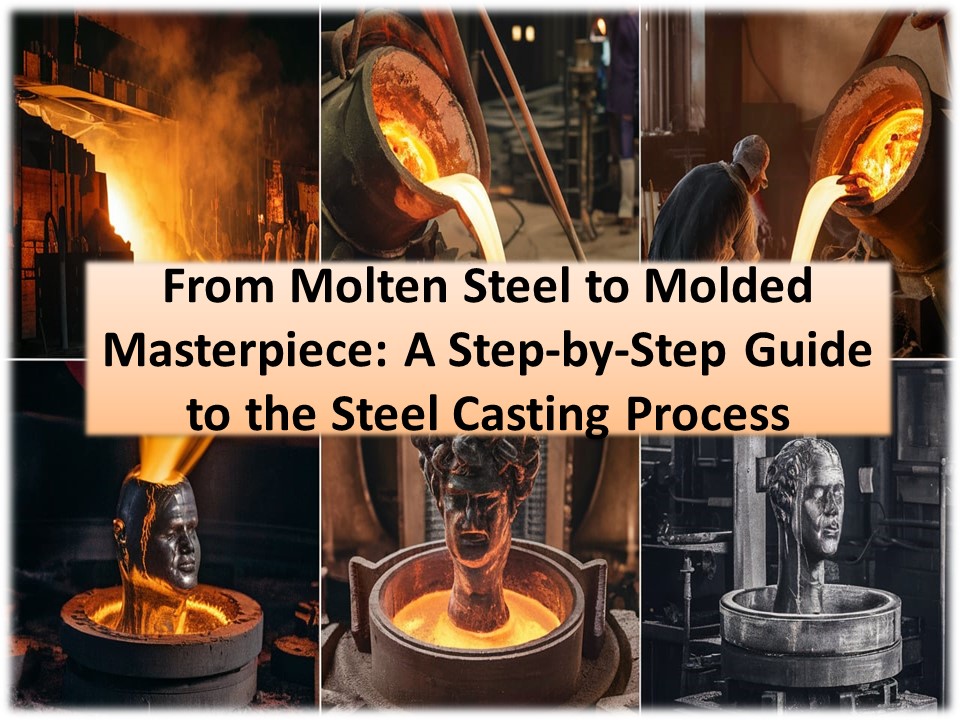Unlocking the Secrets of Molten Steel: A Step-by-Step Guide - PowerPoint PPT Presentation
Title:
Unlocking the Secrets of Molten Steel: A Step-by-Step Guide
Description:
Ultimately, the steel casting process is a true marvel of modern manufacturing and a testament to mortal ingenuity and creativity. After being cooled and allowed to solidify, the metal that has been liquefied is then retrieved from the mould in a solidified state. – PowerPoint PPT presentation
Number of Views:1
Title: Unlocking the Secrets of Molten Steel: A Step-by-Step Guide
1
From Molten Steel to Molded Masterpiece A
Step-by-Step Guide to the Steel Casting Process
2
- Creating intricate metal components for a variety
of uses is the purpose of the steel casting
process, which is an essential step in the
manufacturing business. Steel castings are an
essential component in assuring the strength and
longevity of vital components across a wide range
of industries, including aerospace and
automotive. In this blog, we will go into the
process of steel casting step by step, examining
each phase in depth we will see how the process
works.
3
Casting Production Explained
- There are several process alternatives available
for mass fabricating metal components. In spite
of the fact that 3D printing is all the rage,
classic investment casting remains the most
effective method for high-production runs. How
come? The investment casting technique, which is
used in traditional casting manufacturing, is
both more cost-effective and consistently
dependable. The method of casting in the
contemporary era includes pouring molten metal
into mould holes in order to generate the
required shape. After being cooled and allowed to
solidify, the metal that has been liquefied is
then retrieved from the mould in a solidified
state. - Steel casting manufacturers follows creating a
design, moulding, melting and pouring, shaking
out, and heat treatment and inspection stages
that include the casting process. Continue
reading in order to learn more about each stage.
4
- Step 1 Pattern Creation
- Developing a pattern or mould that represents the
intended form of the steel casting is the first
step in the process. When it comes to the
intricacy of the design, patterns may be crafted
from a variety of materials, including wood,
metal, and other materials. A high level of
accuracy and attention to detail is required for
this process, since any mistakes that are made
will be reflected in the final output. - Step 2 Sand Preparation
- After that, a combination of sand is made for it
to be moulded. The moldable mixture is created by
combining sand, bonding chemicals, and water in a
mixing container. The procedure for preparing the
sand is quite important since it has an impact on
the overall quality of the casting.
5
- Step 3 Mold Creation
- After that, the sand mixture is packed around the
pattern, which results in the formation of a
mould cavity in the shape of the casting that is
required. For the purpose of ensuring that the
design is reproduced accurately, the mould is
meticulously created. - Step 4 Melting and Pouring
- The mould cavity is entirely filled with molten
steel as it is poured into the mould cavity. The
steel is heated at a certain temperature, which
ensures that it is both fluid and defect-free to
the greatest extent possible. - Step 5 Solidification
- Depending on the size of the casting, the process
of allowing the steel to harden in the mould
might take anywhere from a few hours to several
days before it is completed.
6
- Step 6 Shakeout
- When the casting has reached the desired
consistency, it is withdrawn from the mould and
any extra sand is shook away. - Step 7 Cleaning and Finishing
- Impurities and flaws are removed from the casting
during the cleaning process. It is possible to
attain the required surface finish by performing
additional finishing processes, such as grinding
or machining, among other possibilities. - Step 8 Heat Treatment (Optional)
- Annealing, hardening, and tempering are all
examples of applications of heat treatment
procedures that may be used to obtain certain
qualities, such as increased strength or
resistance to corrosion. - Step 9 Inspection and Testing
- In order to guarantee that the casting satisfies
the necessary requirements, it is first examined
for flaws and irregularities, and then subjected
to several types of testing, such as tensile or
impact testing. - Step 10 Packaging and Shipping
- When all is said and done, the casting is either
packed and sent out to clients or kept for later
use.
7
Bottom Line
- In the end, the steel casting process is a true
marvel of modern manufacturing, and a testament
to human ingenuity and creativity. Whether it's a
critical component for a wind turbine or a
precision part for a surgical instrument, steel
casting manufacturers play a vital role in
bringing ideas to life and shaping the world
around us.
8
(No Transcript)































